RENAULT KANGOO 2016 X61 / 2.G Owners Manual
Manufacturer: RENAULT, Model Year: 2016, Model line: KANGOO, Model: RENAULT KANGOO 2016 X61 / 2.GPages: 173, PDF Size: 3.8 MB
Page 131 of 173
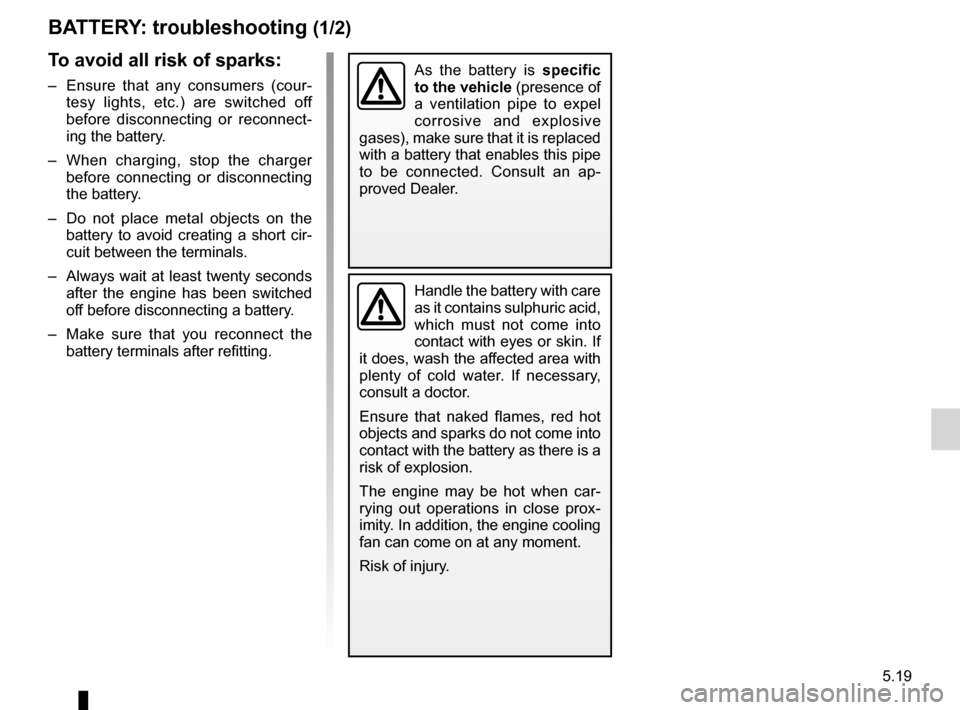
batterytroubleshooting ............................... (up to the end of the DU)
practical advice ..................................... (up to the end of the DU) 5.19
ENG_UD14324_2
Batterie : dépannage (X76 - Renault)
ENG_NU_854-2_X76LL_Renault_5
Battery: troubleshooting
BA ttEry : troubleshooting (1/2)
Handle the battery with care
as it contains sulphuric acid,
which must not come into
contact with eyes or skin. If
it does, wash the affected area with
plenty of cold water. If necessary,
consult a doctor.
Ensure that naked flames, red hot
objects and sparks do not come into
contact with the battery as there is a
risk of explosion.
The engine may be hot when car-
rying out operations in close prox-
imity. In addition, the engine cooling
fan can come on at any moment.
Risk of injury.
t o avoid all risk of sparks:
– Ensure that any consumers (cour-
tesy lights, etc.) are switched off
before disconnecting or reconnect-
ing the battery.
–
When charging, stop the charger
before connecting or disconnecting
the battery.
–
Do not place metal objects on the
battery to avoid creating a short cir-
cuit between the terminals.
–
Always wait at least twenty seconds
after the engine has been switched
off before disconnecting a battery.
–
Make sure that you reconnect the
battery terminals after refitting.
As the battery is specific
to
the vehicle (presence of
a ventilation pipe to expel
corrosive and explosive
gases), make sure that it is replaced
with a battery that enables this pipe
to be connected. Consult an ap-
proved Dealer.
Page 132 of 173

5.20
ENG_UD14324_2
Batterie : dépannage (X76 - Renault)
ENG_NU_854-2_X76LL_Renault_5
BA ttEry: troubleshooting (2/2)
Connect the positive (+) lead A to (+)
t
erminal 1 of the discharged battery,
then
to (+) terminal 2 of the battery sup-
plying the current.
C
onnect the negative (–) lead B to (–)
t
erminal 3 of the battery supplying the
current
and then to (–) terminal 4 of the
discharged battery.
Check that there is no contact between
leads
A and B and that the positive (+)
l
ead A is not touching any metal parts
on the vehicle supplying the current.
Start the engine as normal. As soon as
it
is running, disconnect leads A and B
in the reverse order (4-3-2-1)
connecting a battery charger
the battery charger must be com-
p
atible with a battery with nominal
voltage
of 12 volts.
Switch the engine off and then discon-
nect both battery leads s
tarting with
the
negative terminal .
Do not disconnect the battery when the
engine is running. Follow
the instruc-
t
ions given by the manufacturer of
the
battery charger you are using.
starting the vehicle using the
battery
from another vehicle
If you have to use the battery from an-
other vehicle to start, obtain suitable
jump leads (with a large cross section)
from an approved dealer or, if you al-
ready have jump leads, ensure that
they are in perfect condition.
t
he two batteries must have an iden -
tical
nominal voltage of 12 volts. The
battery supplying the current should
have a capacity (amp-hours, Ah) which
is at least the same as that of the dis-
charged battery.
Ensure that there is no risk of contact
between the two vehicles (risk of short
circuiting when the positive terminals
are connected) and that the discharged
battery is properly connected. Switch
off your vehicle ignition.
Start the engine of the vehicle supply-
ing the current and run it at an interme-
diate engine speed.
Special procedures may be
required to charge some
batteries. Contact your ap-
proved dealer.
Avoid all risk of sparks which may
cause an immediate explosion, and
charge the battery in a well-venti-
lated area. Risk of serious injury.
1A
2
4
B
3
Page 133 of 173
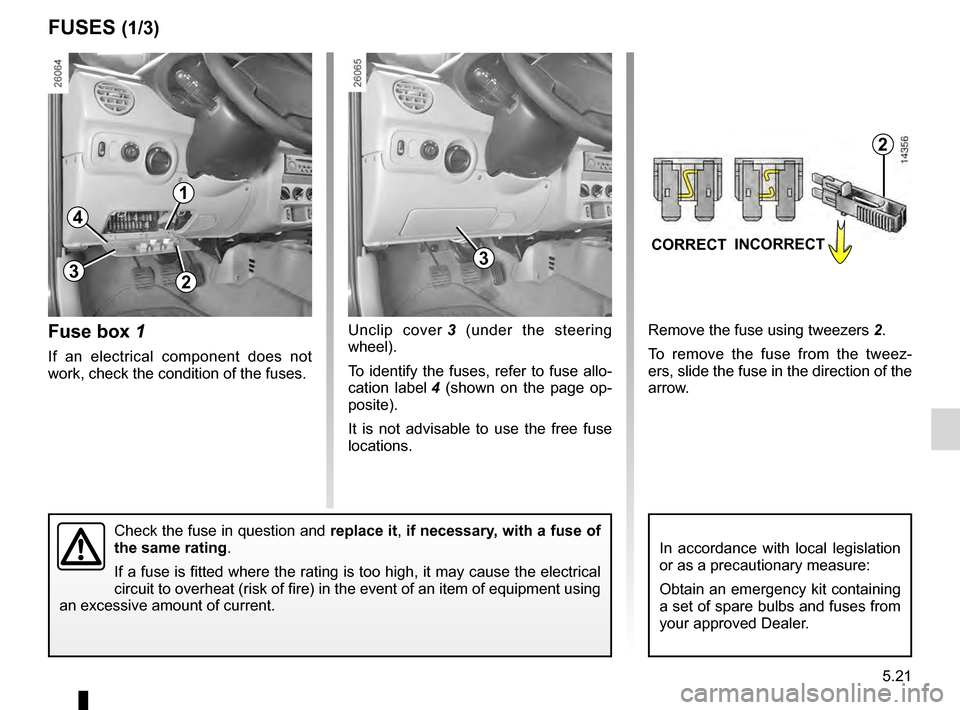
5.21
ENG_UD7323_1
Fusibles 800-1 (X76 - Renault)
ENG_NU_854-2_X76LL_Renault_5
Fuses
Remove the fuse using tweezers 2.
To remove the fuse from the tweez-
ers, slide the fuse in the direction of the
arrow.
In accordance with local legislation
or as a precautionary measure:
Obtain an emergency kit containing
a set of spare bulbs and fuses from
your approved Dealer.
incOrrEct
cOrrEct
FusEs (1/3)
Fuse box 1
If an electrical component does not
work, check the condition of the fuses. U nclip cover
3 (under the steering
wheel).
To identify the fuses, refer to fuse allo-
c
ation label 4 (shown on the page op-
posite).
It is not advisable to use the free fuse
locations.
Check the fuse in question and replace it, if necessary, with a fuse of
the
same rating .
If a fuse is fitted where the rating is too high, it may cause the electrical
circuit to overheat (risk of fire) in the event of an item of equipment using
an excessive amount of current.
4
32
1
3
2
Page 134 of 173
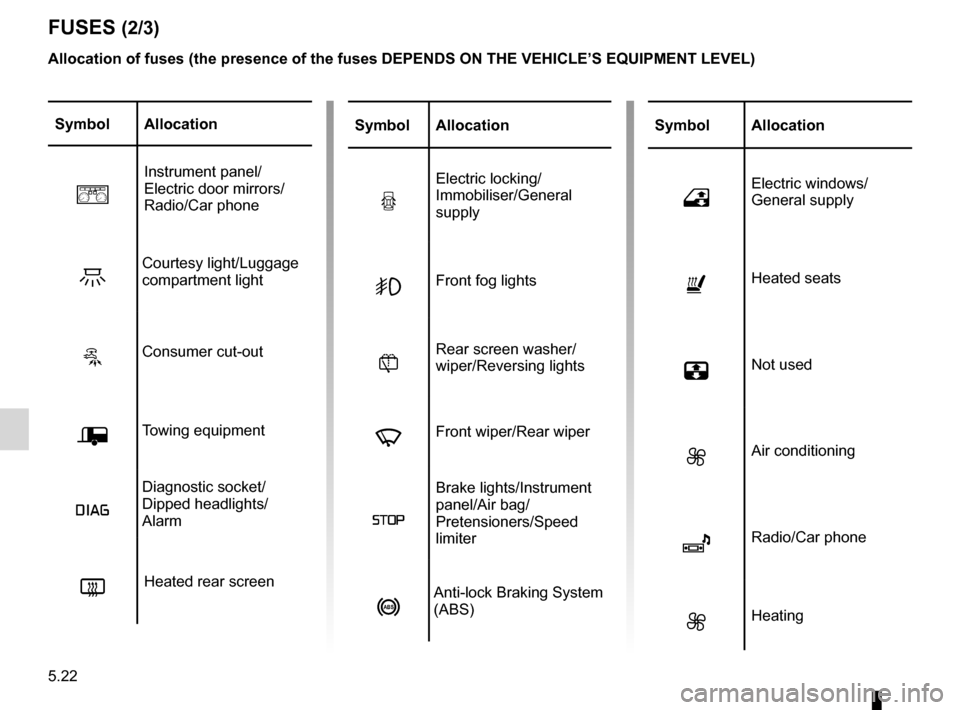
5.22
ENG_UD7323_1
Fusibles 800-1 (X76 - Renault)
ENG_NU_854-2_X76LL_Renault_5
Jaune NoirNoir texte
FusEs (2/3)
Allocation of fuses (the presence of the fuses DEPE nDs On thE VEhiclE’s EQuiPmEnt lEVEl)
symbol Allocation
a
Instrument panel/
Electric door mirrors/
Radio/Car phone
ZCourtesy light/Luggage
compartment light
öConsumer cut-out
ÝTowing equipment
Î
Diagnostic socket/
Dipped headlights/
Alarm
CHeated rear screen
symbol Allocation
hElectric windows/
General supply
ñHeated seats
mNot used
xAir conditioning
îRadio/Car phone
xHeating
symbol Allocation
M
Electric locking/
Immobiliser/General
supply
GFront fog lights
kRear screen washer/
wiper/Reversing lights
fFront wiper/Rear wiper
ß
Brake lights/Instrument
panel/Air bag/
Pretensioners/Speed
limiter
nAnti-lock Braking System
(ABS)
Page 135 of 173
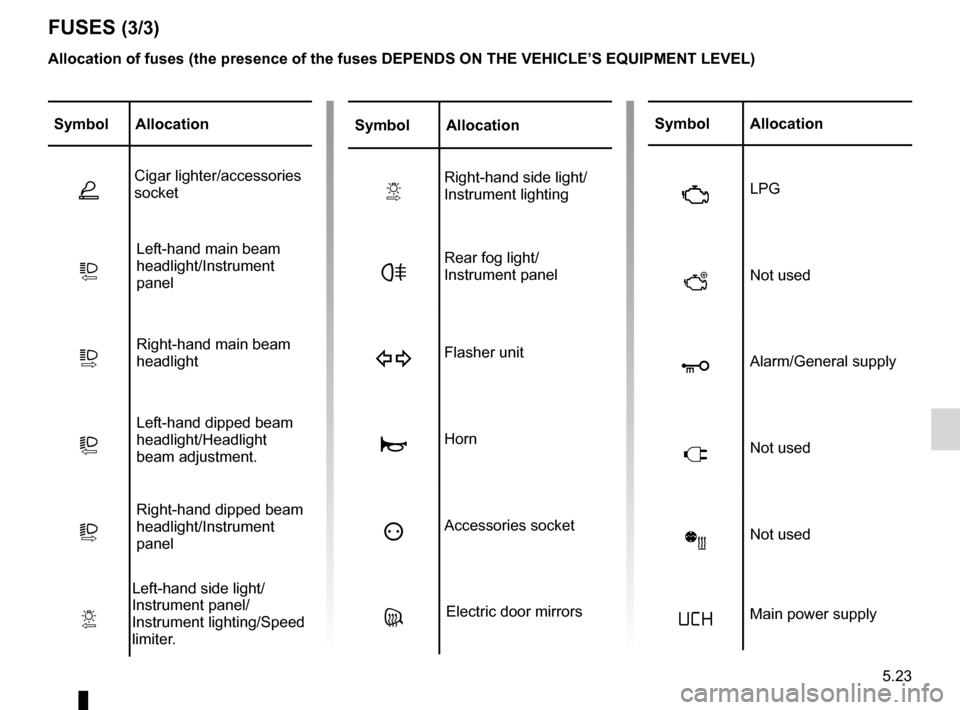
JauneNoirNoir texte
5.23
ENG_UD7323_1
Fusibles 800-1 (X76 - Renault)
ENG_NU_854-2_X76LL_Renault_5
FusEs (3/3)
Allocation of fuses (the presence of the fuses DEPEnDs On thE VEhiclE’s EQuiPmEnt lEVEl)
symbol Allocation
ÆCigar lighter/accessories
socket
Q
Left-hand main beam
headlight/Instrument
panel
PRight-hand main beam
headlight
L
Left-hand dipped beam
headlight/Headlight
beam adjustment.
T
Right-hand dipped beam
headlight/Instrument
panel
Y
Left-hand side light/
Instrument panel/
Instrument lighting/Speed
limiter.
symbol Allocation
VRight-hand side light/
Instrument lighting
FRear fog light/
Instrument panel
DFlasher unit
ÌHorn
ëAccessories socket
gElectric door mirrors
symbol Allocation
ÄLPG
ûNot used
qAlarm/General supply
}Not used
SNot used
ôMain power supply
Page 136 of 173

wiper blades ......................................... (up to the end of the DU)
practical advice ..................................... (up to the end of the DU)
windscreen washer/wiper replacing blades .............................. (up to the end of the DU)
5.24
ENG_UD7324_1
Balais d essuie-vitres (X76 - Renault)
ENG_NU_854-2_X76LL_Renault_5
Jaune NoirNoir texte
Wiper blades
replacing windscreen wiper
blades 1
Lift wiper arm 3.
Turn the wiper blade until it is horizon-
tal.
P
ress tab 2 and slide the wiper blade
downwards
to release hook 4 from the
wiper arm.
Slide the blade (A) then lift it ( B) to re-
lease it.
WinDscrEEn WiPEr BlADEs (1/2)
B
A
12
3
4
56
7
refitting a front or rear wiper
blade
Proceed in reverse order. Make sure
that the blade is correctly locked in po-
sition.
replacing the rear screen
wiper
blade (hinged door)
Lift wiper arm 6.
P
ress tab 5 and slide the wiper blade
downwards to release hook
7.
Check the condition of the wiper
blades. You are responsible for their
service life:
–
clean the blades, windscreen and
rear screen regularly with soapy
water;
–
do not use them when the wind -
screen or rear screen are dry;
–
free them from the windscreen or
rear screen when they have not
been used for a long time.
Page 137 of 173
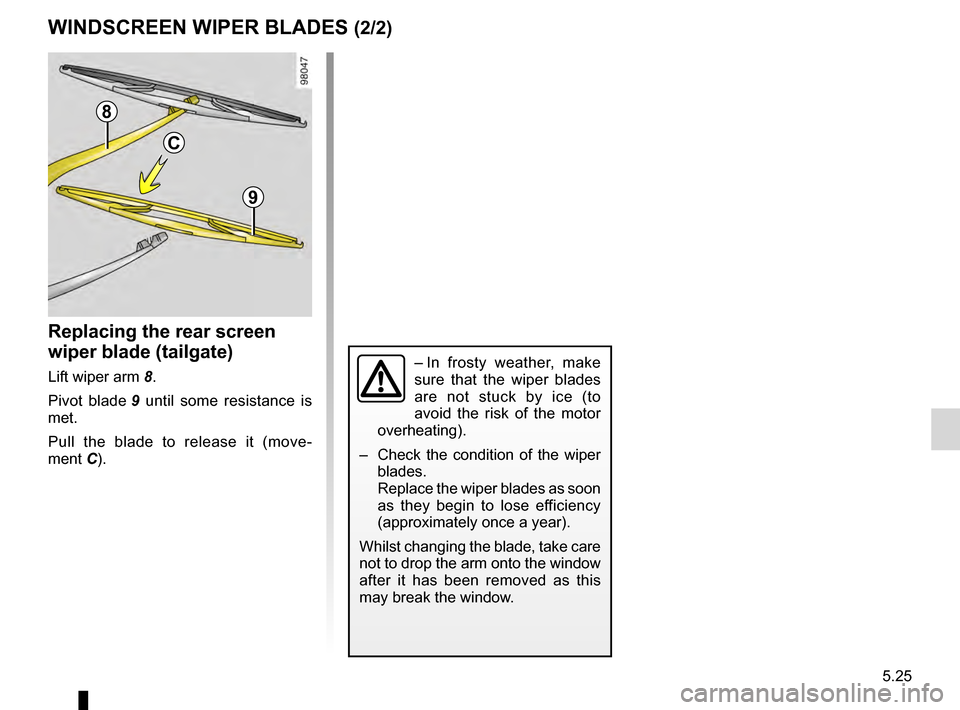
JauneNoirNoir texte
5.25
ENG_UD7324_1
Balais d essuie-vitres (X76 - Renault)
ENG_NU_854-2_X76LL_Renault_5
– In frosty weather, make
sure that the wiper blades
are not stuck by ice (to
avoid the risk of the motor
overheating).
–
Check the condition of the wiper
blades.
Replace the wiper blades as soon
as they begin to lose efficiency
(approximately once a year).
Whilst changing the blade, take care
not to drop the arm onto the window
after it has been removed as this
may break the window.
c
8
9
replacing the rear screen
wiper
blade (tailgate)
Lift wiper arm 8.
P
ivot blade 9 until some resistance is
met.
Pull the blade to release it (move-
ment
C).
WinDscrEEn WiPEr BlADEs (2/2)
Page 138 of 173
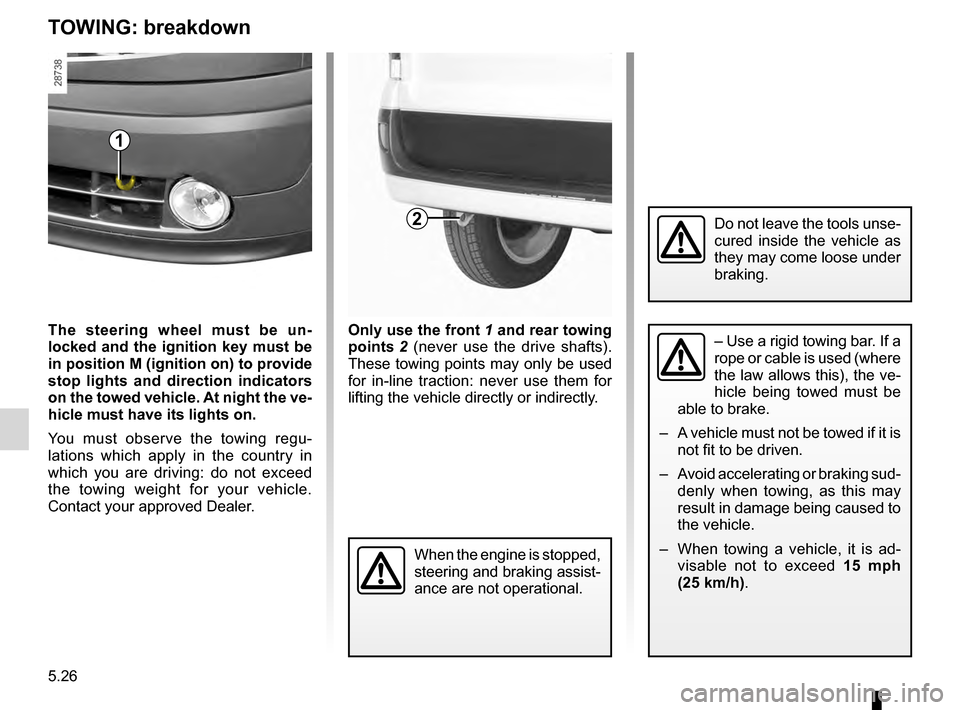
practical advice ..................................... (up to the end of the DU)
towing breakdown ...................................... (up to the end of the DU)
5.26
ENG_UD7325_1
Remorquage : dépannage (X76 - Renault)
ENG_NU_854-2_X76LL_Renault_5
Only use the front 1 and rear towing
points 2 (never use the drive shafts).
These towing points may only be used
for in-line traction: never use them for
lifting the vehicle directly or indirectly.
Towing: breakdown
When the engine is stopped,
steering and braking assist-
ance are not operational.
t he steering wheel must be un-
locked
and the ignition key must be
in
position m (ignition on) to provide
s
top lights and direction indicators
on
the towed vehicle. At night the ve-
hicle
must have its lights on.
You must observe the towing regu-
lations which apply in the country in
which you are driving: do not exceed
the towing weight for your vehicle.
Contact your approved Dealer.
tOWing: breakdown
1
2
– Use a rigid towing bar. If a
rope or cable is used (where
the law allows this), the ve-
hicle being towed must be
able to brake.
–
A vehicle must not be towed if it is
not fit to be driven.
–
Avoid accelerating or braking sud -
denly when towing, as this may
result in damage being caused to
the vehicle.
–
When towing a vehicle, it is ad -
visable not to exceed 1
5 mph
(25 km/h).
Do not leave the tools unse-
cured inside the vehicle as
they may come loose under
braking.
Page 139 of 173
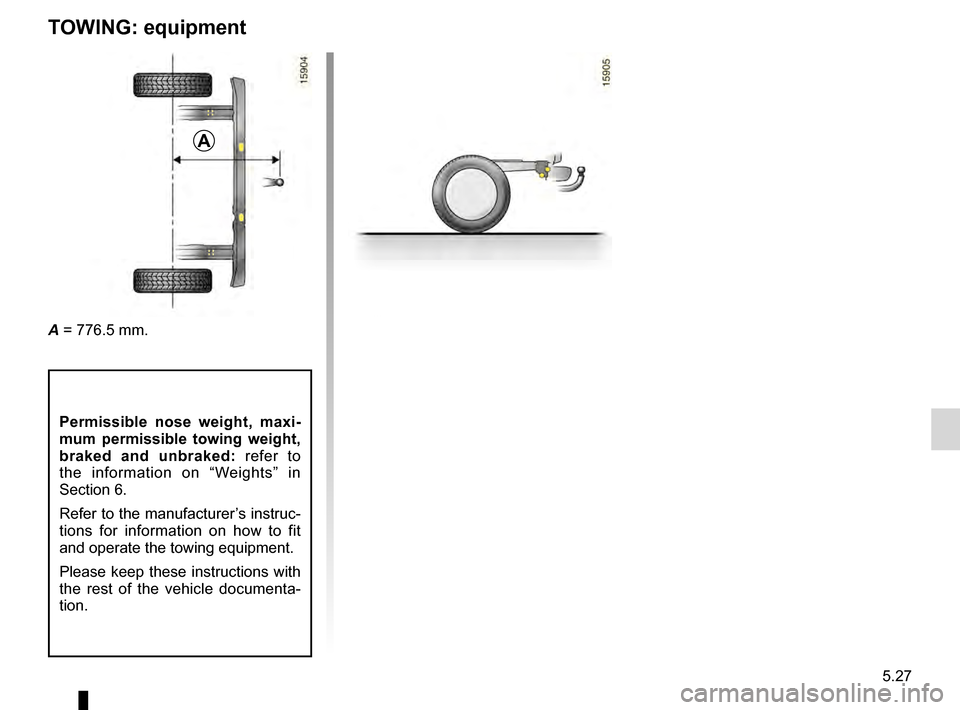
practical advice ..................................... (up to the end of the DU)
towing towing equipment ............................ (up to the end of the DU) 5.27
ENG_UD7326_1
Remorquage attelage (X76 - Renault)
ENG_NU_854-2_X76LL_Renault_5
A = 776.5 mm.
Towing: equipment
Permissible nose weight, maxi-
m
um permissible towing weight,
b
raked and unbraked: refer to
the information on “Weights” in
Section
6.
Refer to the manufacturer’s instruc-
tions for information on how to fit
and operate the towing equipment.
Please keep these instructions with
the rest of the vehicle documenta-
tion.
tOWing: equipment
A
Page 140 of 173
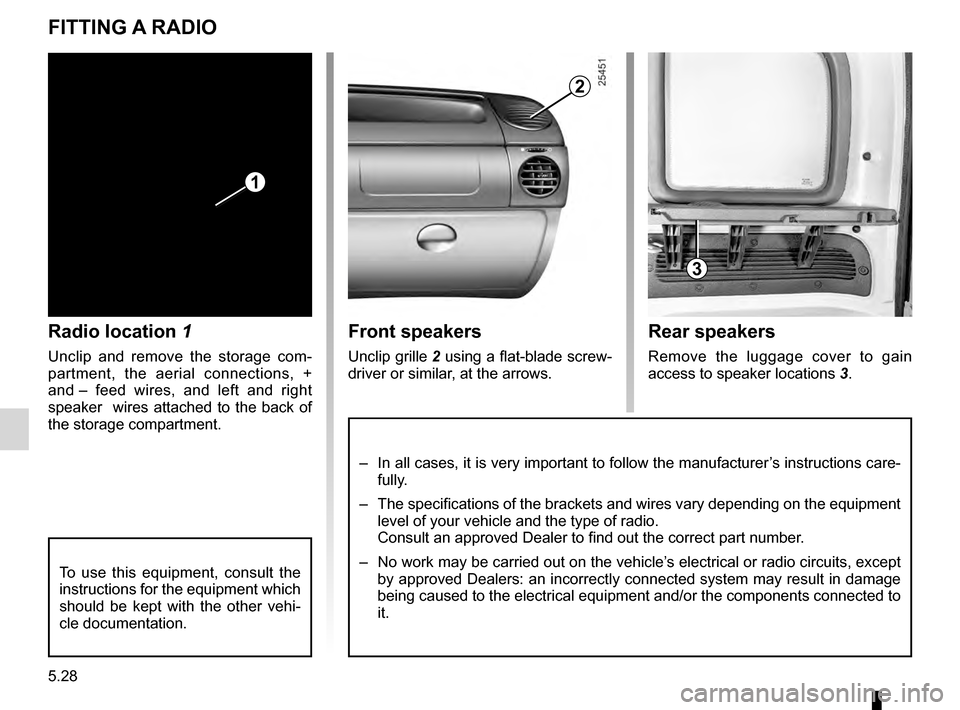
practical advice ..................................... (up to the end of the DU)
fitting a radio ......................................... (up to the end of the DU)
fitting a radio ......................................... (up to the end of the DU)
radio fitting a radio ................................... (up to the end of the DU)
5.28
ENG_UD7327_1
Prééquipement radio (X76 - Renault)
ENG_NU_854-2_X76LL_Renault_5
Fitting a radio
rear speakers
Remove the luggage cover to gain
access to speaker locations
3.
Front speakers
Unclip grille 2 using a flat-blade screw-
driver or similar, at the arrows.
radio location 1
Unclip and remove the storage com-
partment, the aerial connections, +
a
nd – feed wires, and left and right
speaker wires attached to the back of
the storage compartment.
Fitting A rADiO
1
2
3
To use this equipment, consult the
instructions for the equipment which
should be kept with the other vehi-
cle documentation.
– In all cases, it is very important to follow the manufacturer’s instructions care-
fully.
–
The specifications of the brackets and wires vary depending on the equipment
level of your vehicle and the type of radio.
Consult an approved Dealer to find out the correct part number.
–
No work may be carried out on the vehicle’s electrical or radio circuits, except
by approved Dealers: an incorrectly connected system may result in damage
being caused to the electrical equipment and/or the components connected to
it.